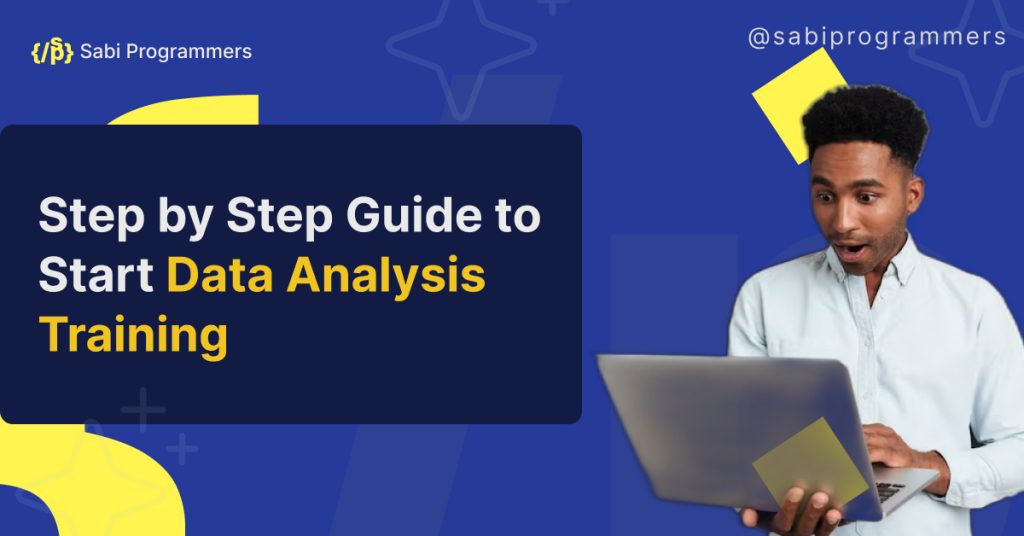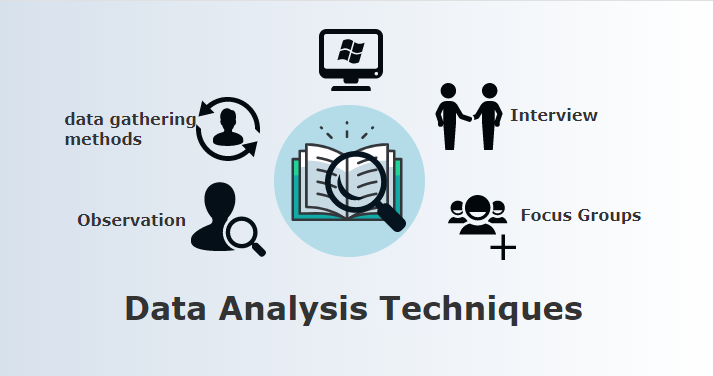Step by Step Guide to Start Data Analysis Training

Hey there aspiring data analyst!
Are you interested in using data to make better business decisions and uncover insights?
If so, then a career in data analysis might be right for you. As a data analyst, you’ll be responsible for collecting, analyzing, and interpreting complex data to help organizations make informed decisions.
But where do you begin?
In this guide, we’ll cover everything you need to know to become a successful data analyst.
Note, at SabiProgrammers, we offer an online data analysis course designed for beginners with no prior experience in data analysis.
Check out our courses here >>
First, let’s start with the basics.
What is data analysis?

Data analysis is the process of collecting, cleaning, processing, and analyzing data to uncover insights and make informed decisions.
Data analysts use tools like Excel, Python, SQL, and other statistical software to perform these tasks.
As a data analyst, you’ll be responsible for:
- Collecting and organizing data from various sources
- Cleaning and pre-processing data to remove errors, inconsistencies, and duplicates
- Analyzing data using statistical methods and machine learning algorithms
- Creating visualizations and reports to communicate findings to stakeholders
- Identifying trends, patterns, and insights to help organizations make informed decisions
Now that you understand what data analysis is let’s talk about the skills you need to become a data analyst.
Skills needed to become a data analyst
- Analytical Skills: As a data analyst, you’ll be required to analyze data to uncover insights, so having strong analytical skills is essential. You should be comfortable with working with numbers and be able to spot trends and patterns in data.
- Technical Skills: Data analysts need to be familiar with data analysis tools like Excel, SQL, and Python. Additionally, familiarity with statistical software like R or SAS is also helpful.
- Communication Skills: After analyzing data, you’ll be responsible for communicating your findings to stakeholders who might not be familiar with data analysis. Therefore, having strong communication skills is essential for data analysts.
- Attention to Detail: Data analysis is a meticulous process that requires you to pay close attention to detail. You’ll need to be able to spot inconsistencies or errors in data and clean them up.
- Business Acumen: Lastly, as a data analyst, you’ll be working with data to help organizations make better decisions. Having an understanding of business operations, strategies, and objectives is essential to help you analyze data in a way that supports business decisions.
Now that you know the skills needed to become a data analyst, let’s talk about how you can get started.
How to become a data analyst
- Education: Many data analysts have a degree in a related field like statistics, mathematics, or computer science. However, it’s possible to become a data analyst without a formal degree, as long as you have the skills needed to perform the job.
- Learn Data Analysis Tools: You’ll need to become familiar with data analysis tools like Excel, SQL, and Python. There are many online courses and tutorials available that can help you learn these tools.
- Practice with Real Data: The best way to learn data analysis is by working with real data. Look for public datasets that you can use to practice your skills. Kaggle is a great resource for finding public datasets.
- Build a Portfolio: To showcase your skills to potential employers, you’ll need to build a portfolio of projects. Start with small projects, and as you get more experience, you can work on more complex projects.
- Apply for Jobs: Once you have the necessary skills and experience, it’s time to start applying for jobs. Look for job postings that match your skill set and experience level.
At SabiProgrammers, we offer an online data analysis course designed for beginners with no prior experience in data analysis.
Check out our courses here >>
Tools for Data Analysts
There are many tools available that can make the job of a data analyst easier. Here are a few tools that you should consider learning:
Excel: Excel is a widely-used spreadsheet software that allows data analysts to manipulate and analyze large amounts of data. It has a wide range of features, including data visualization tools, pivot tables, and advanced formula functions. Excel is a great starting point for data analysts and can be used for a variety of tasks, from basic data cleaning and filtering to more complex data modeling and forecasting.
SQL: Structured Query Language (SQL) is a programming language used to manage and manipulate relational databases. As a data analyst, you’ll often be working with large amounts of data stored in databases, so it’s essential to have a solid understanding of SQL. You’ll be able to extract, transform, and load (ETL) data from databases, perform data analysis, and create reports and visualizations.
Python: Python is a general-purpose programming language that has become increasingly popular in the data science community. It has a vast range of libraries and tools that can be used for data analysis, visualization, and machine learning. As a data analyst, learning Python can help you automate data processing, build complex data models, and create interactive dashboards.
R: R is a programming language and software environment used for statistical computing and graphics. It has a vast array of tools for data analysis, visualization, and machine learning. R is particularly useful for data analysts working with large datasets, as it has efficient memory management and can handle data manipulations with ease.
Tableau: Tableau is a data visualization software that allows data analysts to create interactive dashboards and reports. It has a user-friendly interface that makes it easy to connect to different data sources, create visualizations, and share insights with stakeholders. Tableau is an excellent tool for data analysts who need to communicate complex data insights to non-technical audiences.
Power BI: Power BI is a business analytics service by Microsoft that provides interactive visualizations and business intelligence capabilities. It allows data analysts to create reports and dashboards that can be accessed from anywhere, using any device. Power BI is a great tool for data analysts working in organizations that use other Microsoft products, such as Excel and SharePoint.
Analytics: Analytics is an essential part of digital marketing, as it helps you measure the effectiveness of your campaigns and optimize your strategies for better results. You should be familiar with tools like Google Analytics, which can help you track website traffic, user behavior, conversion rates, and more.
at SabiProgrammers, we teach you how to use the tools in our data analysis course.
Check out our courses here >>
Next step is to learn a Programming Language
Once you’ve got a handle on the basics of data analysis, it’s time to pick a programming language to focus on. Python is a popular choice for data analysis, thanks to its versatility, ease of use, and vast array of libraries and tools.
Other options include R and SQL, depending on your interests and career goals.
There are many online resources available to learn programming languages, but you can also enroll in a data analysis course that includes programming instruction, like the one offered by us at Sabi Programmers Training Center.
Check out our data analysis course here >>
In addition to programming languages, there are many tools and platforms that data analysts use to process, visualize, and analyze data. Some of the most popular include:
- Excel: A widely used tool for basic data analysis and visualization
- Tableau: A data visualization tool that allows you to create interactive dashboards and reports
- Power BI: A business analytics tool that lets you analyze data and share insights across your organization
- Jupyter Notebook: An open-source web application that allows you to create and share documents that contain live code, equations, visualizations, and narrative text
- Pandas: A Python library for data manipulation and analysis
Next, you need to start practicing with Real-Life Data
![The 7 Most Useful Data Analysis Techniques [2023 Guide]](https://dpbnri2zg3lc2.cloudfront.net/en/wp-content/uploads/2021/01/data-analysis-technique-time-series.jpg)
One of the most important things you can do to become a skilled data analyst is to practice with real-life data. There are many public data sets available online that you can use for this purpose, such as the datasets available on Kaggle.
You can also work on real-life data analysis projects, such as analyzing customer data for a company or examining trends in social media usage.
These projects will give you hands-on experience and help you develop your skills and knowledge.
Next start building a Portfolio as a Data Analyst
Building a portfolio is an essential step in showcasing your skills and experience as a data analyst. You can start by working on personal projects or contributing to open-source projects.
You can also create a portfolio website to showcase your work and share it with potential employers or clients.
Some examples of projects you can include in your portfolio are:
- Data visualization projects, such as creating interactive dashboards or heat maps
- Predictive modeling projects, such as building a machine learning model to predict customer churn
- Data cleaning and wrangling projects, such as cleaning and organizing messy data sets
- Exploratory data analysis projects, such as examining trends in social media usage or analyzing the effectiveness of marketing campaigns
Next thing you need to be doing is staying up-to-date with Industry Trends
As with any technology-related field, it’s crucial to stay up-to-date with the latest trends and developments in data analysis.
This means regularly reading industry blogs, attending conferences and events, and networking with other professionals in the field.
It’s also important to continue learning and expanding your skills through additional courses, certifications, and training programs.
Sabi Programmers Training Center offers a range of courses and training programs for data analysis, including Data Analysis with Python, Data Visualization with Tableau, and Advanced Excel for Business.
Check out our courses here >>
In conclusion, data analysis is a fascinating and in-demand field that offers many opportunities for growth and career advancement.
By following the steps outlined above, you can learn the skills and tools you need to become a successful data analyst and build a rewarding career in this exciting field.